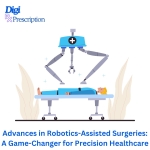Introduction
Robotic-assisted surgery is revolutionizing modern healthcare, offering unparalleled precision, minimal invasiveness, and faster recovery times. From the widely used da Vinci Surgical System to next-generation AI-driven robots, technology is transforming how surgeries are performed.
In this blog, we’ll explore the latest advancements in robotic-assisted surgery, their impact on patient outcomes, and the future of robotic healthcare.
1. What is Robotics-Assisted Surgery?
Robotic-assisted surgery allows surgeons to perform complex procedures with enhanced control and accuracy. These systems use:
???? Robotic arms controlled by the surgeon for precise movements.
???? High-definition 3D visualization for better visibility of internal structures.
???? Minimally invasive techniques, leading to smaller incisions and reduced scarring.
Key Benefits of Robotic Surgery
✅ Higher precision – Robots eliminate hand tremors and allow micro-movements.
✅ Smaller incisions – Minimally invasive techniques reduce pain and scarring.
✅ Shorter hospital stays – Faster recovery times mean patients return home sooner.
✅ Reduced risk of infection – Less exposure to external contaminants.
✅ Less blood loss & quicker healing – Smaller cuts mean fewer complications.
2. The Role of the da Vinci Surgical System
How Does the da Vinci Robot Work?
The da Vinci Surgical System, developed by Intuitive Surgical, is the most widely used robotic surgery system in the world. It consists of:
???? A console where the surgeon operates using hand and foot controls.
???? Four robotic arms that hold surgical instruments and a 3D camera.
???? AI-powered assistance for unmatched precision.
Common Procedures Using da Vinci Surgery
???? Orthopedic Surgeries – Knee and hip replacements.
⚕️ Gynecological Surgeries – Hysterectomies and fibroid removal.
???? Urological Surgeries – Prostatectomies and kidney procedures.
???? Cardiac Surgeries – Heart valve repairs and bypass surgery.
Success Rate & Impact
- Over 10 million robotic-assisted procedures have been performed worldwide.
- Studies show reduced complications and shorter recovery times compared to traditional surgery.
3. Next-Generation Surgical Robots
While the da Vinci system is leading the way, new robotic systems are emerging with enhanced capabilities:
???? Versius by CMR Surgical – Portable & More Flexible
- Smaller and more affordable than da Vinci.
- Allows hospitals with lower budgets to access robotic surgery.
⚡ Hugo™ RAS System by Medtronic – AI-Powered Precision
- Uses real-time AI analysis to enhance surgical precision.
- Focuses on minimally invasive laparoscopic surgeries.
???? Mako by Stryker – Revolutionizing Joint Replacements
- Specializes in robotic-assisted knee and hip replacements.
- Uses CT scans to create a personalized surgical plan.
???? Neuromate by Renishaw – Brain Surgery Assistance
- Designed for neurosurgery, helping with brain tumor removals and deep brain stimulation.
4. The Future of Robotics in Surgery
???? AI & Machine Learning Integration – Robots will soon predict complications before they happen.
???? Remote Robotic Surgery – Surgeons will perform operations remotely, improving access to expert care worldwide.
???? Human-Robot Collaboration – AI-powered robots will assist, not replace surgeons, making complex procedures even safer.
???? Wider Adoption in Small Hospitals – As robotic systems become cheaper, more hospitals will integrate them into routine care.
5. Challenges & Ethical Considerations
???? High Costs – Robotic surgery systems are expensive, limiting access in developing countries.
???? Training Requirements – Surgeons must undergo extensive training to use robotic systems effectively.
???? Risk of Malfunctions – Even with advanced AI, robotic systems can fail or experience technical errors.
???? Ethical Concerns – Some worry that AI-driven surgery may reduce human oversight in critical procedures.
Conclusion
Robotic-assisted surgery is redefining modern medicine, offering greater precision, less pain, and faster recovery times. With advancements in AI, remote surgery, and next-gen robotic systems, the future of surgery is becoming more efficient, safe, and accessible.
As technology evolves, robotics will play an even greater role in healthcare, ensuring better outcomes for millions of patients worldwide.
???? Would you feel comfortable undergoing robotic-assisted surgery?
References:
- Intuitive Surgical – da Vinci Surgery Overview: www.intuitive.com
- Medtronic – Hugo™ RAS System Details: www.medtronic.com
- CMR Surgical – Versius Robotic System: www.cmrsurgical.com
- Harvard Medical School – The Impact of Surgical Robots: www.health.harvard.edu

